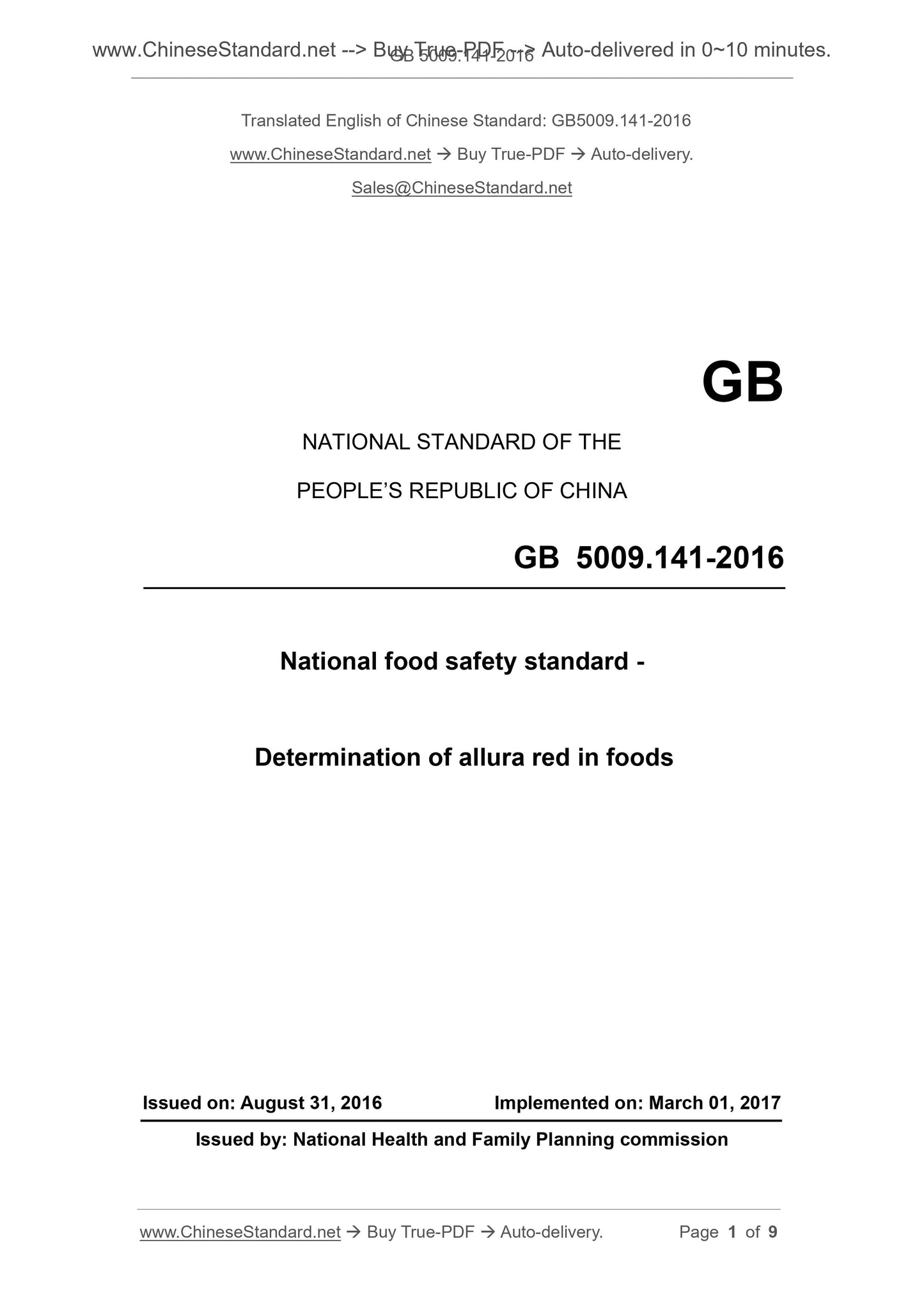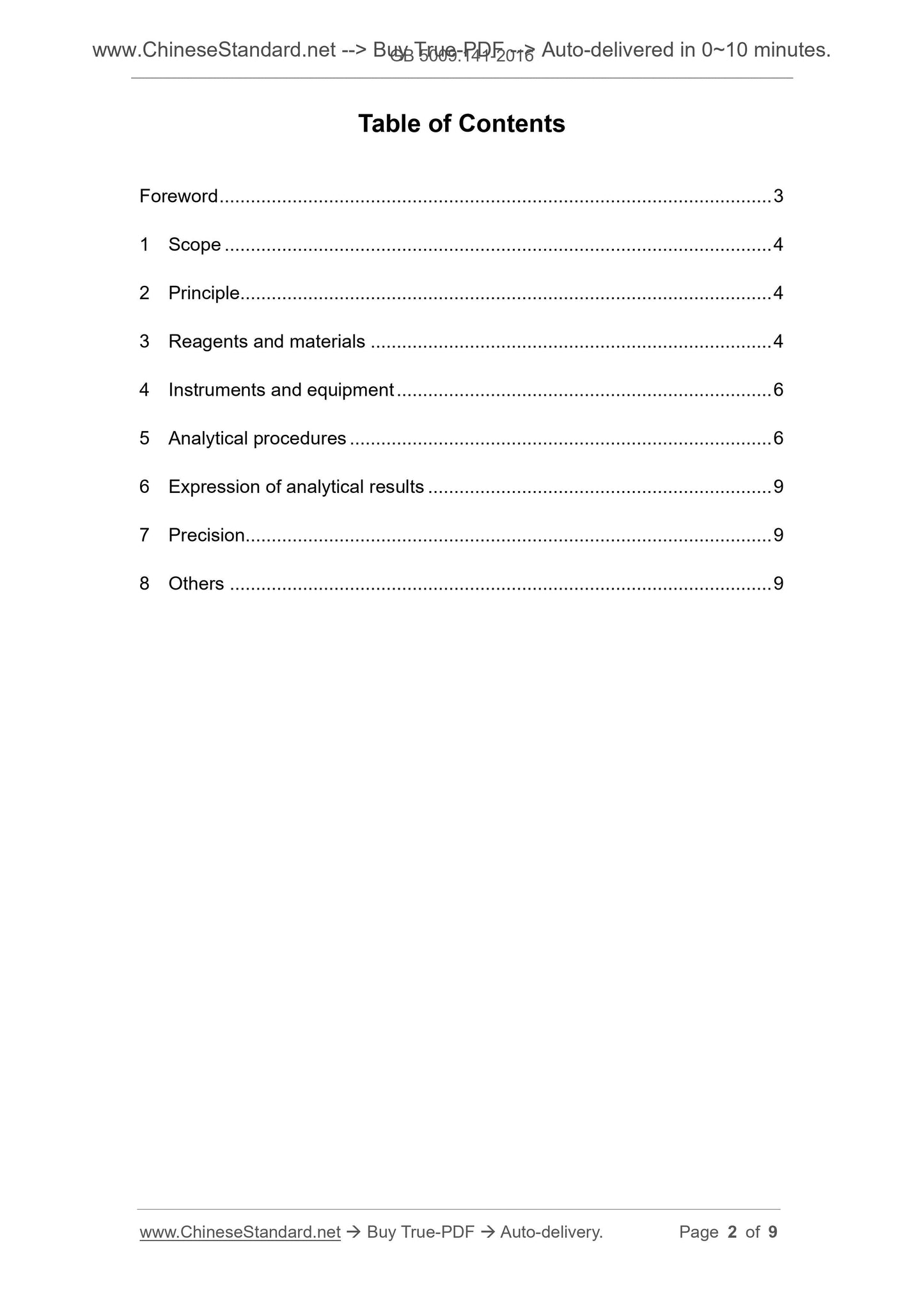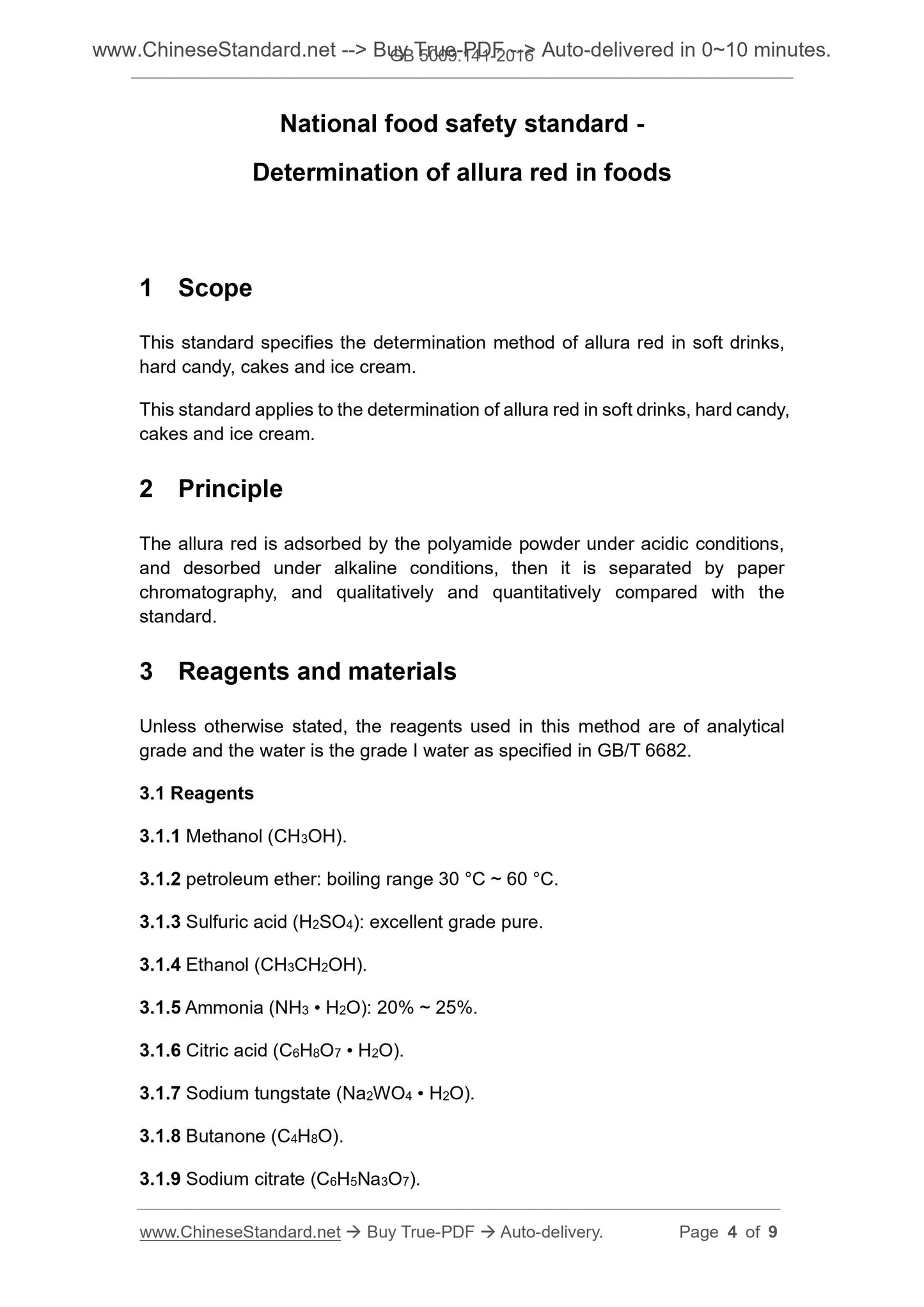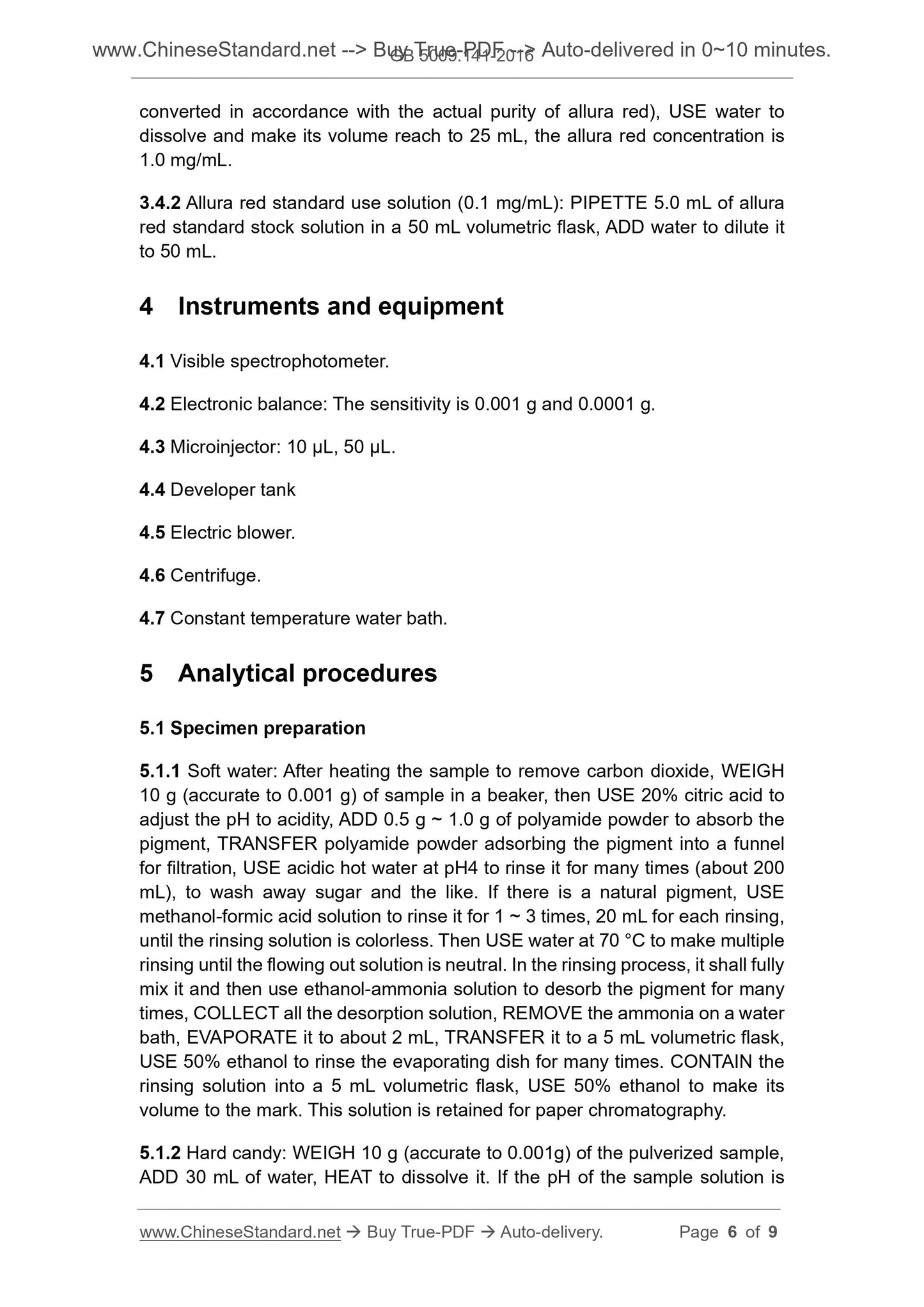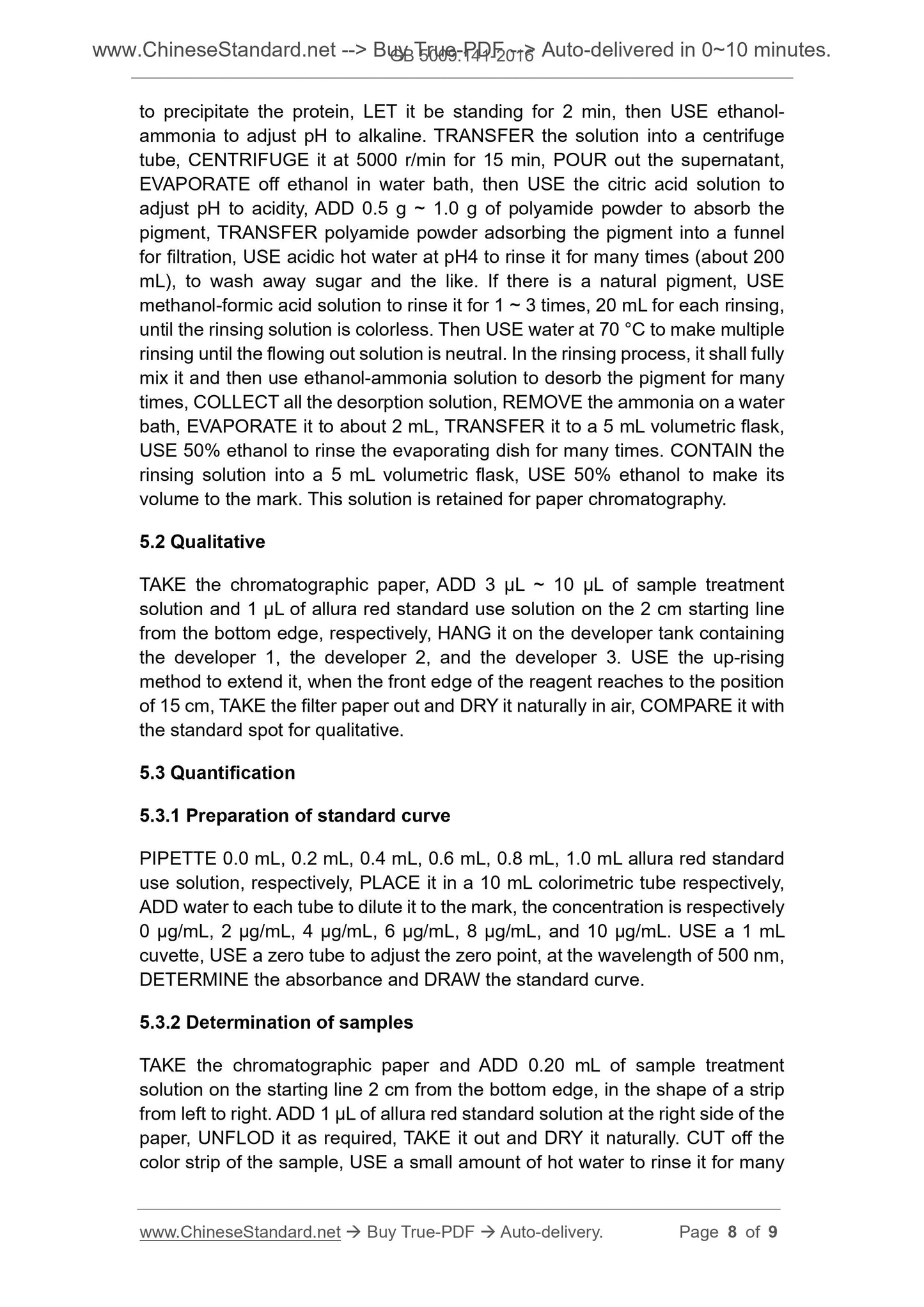1
/
of
5
www.ChineseStandard.us -- Field Test Asia Pte. Ltd.
GB 5009.141-2016 English PDF
GB 5009.141-2016 English PDF
Regular price
$70.00
Regular price
Sale price
$70.00
Unit price
/
per
Shipping calculated at checkout.
Couldn't load pickup availability
GB 5009.141-2016: National food safety standard -- Determination of allura red in foods
Delivery: 9 seconds. Download (& Email) true-PDF + Invoice.
Get Quotation: Click GB 5009.141-2016 (Self-service in 1-minute)
Historical versions (Master-website): GB 5009.141-2016
Preview True-PDF (Reload/Scroll-down if blank)
GB 5009.141-2016
GB
NATIONAL STANDARD OF THE
PEOPLE’S REPUBLIC OF CHINA
National food safety standard -
Determination of allura red in foods
ISSUED ON. AUGUST 31, 2016
IMPLEMENTED ON. MARCH 01, 2017
Issued by. National Health and Family Planning commission
Table of Contents
Foreword ... 3
1 Scope ... 4
2 Principle... 4
3 Reagents and materials ... 4
4 Instruments and equipment ... 6
5 Analytical procedures ... 6
6 Expression of analytical results ... 9
7 Precision... 9
8 Others ... 9
National food safety standard -
Determination of allura red in foods
1 Scope
This standard specifies the determination method of allura red in soft drinks,
hard candy, cakes and ice cream.
This standard applies to the determination of allura red in soft drinks, hard candy,
cakes and ice cream.
2 Principle
The allura red is adsorbed by the polyamide powder under acidic conditions,
and desorbed under alkaline conditions, then it is separated by paper
chromatography, and qualitatively and quantitatively compared with the
standard.
3 Reagents and materials
Unless otherwise stated, the reagents used in this method are of analytical
grade and the water is the grade I water as specified in GB/T 6682.
3.1 Reagents
3.1.1 Methanol (CH3OH).
3.1.2 petroleum ether. boiling range 30 °C ~ 60 °C.
3.1.3 Sulfuric acid (H2SO4). excellent grade pure.
3.1.4 Ethanol (CH3CH2OH).
3.1.5 Ammonia (NH3 • H2O). 20% ~ 25%.
3.1.6 Citric acid (C6H8O7 • H2O).
3.1.7 Sodium tungstate (Na2WO4 • H2O).
3.1.8 Butanone (C4H8O).
3.1.9 Sodium citrate (C6H5Na3O7).
converted in accordance with the actual purity of allura red), USE water to
dissolve and make its volume reach to 25 mL, the allura red concentration is
1.0 mg/mL.
3.4.2 Allura red standard use solution (0.1 mg/mL). PIPETTE 5.0 mL of allura
red standard stock solution in a 50 mL volumetric flask, ADD water to dilute it
to 50 mL.
4 Instruments and equipment
4.1 Visible spectrophotometer.
4.2 Electronic balance. The sensitivity is 0.001 g and 0.0001 g.
4.3 Microinjector. 10 μL, 50 μL.
4.4 Developer tank
4.5 Electric blower.
4.6 Centrifuge.
4.7 Constant temperature water bath.
5 Analytical procedures
5.1 Specimen preparation
5.1.1 Soft water. After heating the sample to remove carbon dioxide, WEIGH
10 g (accurate to 0.001 g) of sample in a beaker, then USE 20% citric acid to
adjust the pH to acidity, ADD 0.5 g ~ 1.0 g of polyamide powder to absorb the
pigment, TRANSFER polyamide powder adsorbing the pigment into a funnel
for filtration, USE acidic hot water at pH4 to rinse it for many times (about 200
mL), to wash away sugar and the like. If there is a natural pigment, USE
methanol-formic acid solution to rinse it for 1 ~ 3 times, 20 mL for each rinsing,
until the rinsing solution is colorless. Then USE water at 70 °C to make multiple
rinsing until the flowing out solution is neutral. In the rinsing process, it shall fully
mix it and then use ethanol-ammonia solution to desorb the pigment for many
times, COLLECT all the desorption solution, REMOVE the ammonia on a water
bath, EVAPORATE it to about 2 mL, TRANSFER it to a 5 mL volumetric flask,
USE 50% ethanol to rinse the evaporating dish for many times. CONTAIN the
rinsing solution into a 5 mL volumetric flask, USE 50% ethanol to make its
volume to the mark. This solution is retained for paper chromatography.
5.1.2 Hard candy. WEIGH 10 g (accurate to 0.001g) of the pulverized sample,
ADD 30 mL of water, HEAT to dissolve it. If the pH of the sample solution is
to precipitate the protein, LET it be standing for 2 min, then USE ethanol-
ammonia to adjust pH to alkaline. TRANSFER the solution into a centrifuge
tube, CENTRIFUGE it at 5000 r/min for 15 min, POUR out the supernatant,
EVAPORATE off ethanol in water bath, then USE the citric acid solution to
adjust pH to acidity, ADD 0.5 g ~ 1.0 g of polyamide powder to absorb the
pigment, TRANSFER polyamide powder adsorbing the pigment into a funnel
for filtration, USE acidic hot water at pH4 to rinse it for many times (about 200
mL), to wash away sugar and the like. If there is a natural pigment, USE
methanol-formic acid solution to rinse it for 1 ~ 3 times, 20 mL for each rinsing,
until the rinsing solution is colorless. Then USE water at 70 °C to make multiple
rinsing until the flowing out solution is neutral. In the rinsing process, it shall fully
mix it and then use ethanol-ammonia solution to desorb the pigment for many
times, COLLECT all the desorption solution, REMOVE the ammonia on a water
bath, EVAPORATE it to about 2 mL, TRANSFER it to a 5 mL volumetric flask,
USE 50% ethanol to rinse the evaporating dish for many times. CONTAIN the
rinsing solution into a 5 mL volumetric flask, USE 50% ethanol to make its
volume to the mark. This solution is retained for paper chromatography.
5.2 Qualitative
TAKE the chromatographic paper, ADD 3 μL ~ 10 μL of sample treatment
solution and 1 μL of allura red standard use solution on the 2 cm starting line
from the bottom edge, respectively, HANG it on the developer tank containing
the developer 1, the developer 2, and the developer 3. USE the up-rising
method to extend it, when the front edge of the reagent reaches to the position
of 15 cm, TAKE the filter paper out and DRY it naturally in air, COMPARE it with
the standard spot for qualitative.
5.3 Quantification
5.3.1 Preparation of standard curve
PIPETTE 0.0 mL, 0.2 mL, 0.4 mL, 0.6 mL, 0.8 mL, 1.0 mL allura red standard
use solution, respectively, PLACE it in a 10 mL colorimetric tube respectively,
ADD water to each tube to dilute it to the mark, the concentration is respectively
0 μg/mL, 2 μg/mL, 4 μg/mL, 6 μg/mL, 8 μg/mL, and 10 μg/mL. USE a 1 mL
cuvette, USE a zero tube to adjust the zero point, at the wavelength of 500 nm,
DETERMINE the absorbance and DRAW the standard curve.
5.3.2 Determination of samples
TAKE the chromatographic paper and ADD 0.20 mL of sample treatment
solution on the starting line 2 cm from the bottom edge, in the shape of a strip
from left to right. ADD 1 μL of allura red standard solution at the right side of the
paper, UNFLOD it as required, TAKE it out and DRY it naturally. CUT off the
color strip of the sample, USE a small amount of hot water to rinse it for many
GB 5009.141-2016
GB
NATIONAL STANDARD OF THE
PEOPLE’S REPUBLIC OF CHINA
National food safety standard -
Determination of allura red in foods
ISSUED ON. AUGUST 31, 2016
IMPLEMENTED ON. MARCH 01, 2017
Issued by. National Health and Family Planning commission
Table of Contents
Foreword ... 3
1 Scope ... 4
2 Principle... 4
3 Reagents and materials ... 4
4 Instruments and equipment ... 6
5 Analytical procedures ... 6
6 Expression of analytical results ... 9
7 Precision... 9
8 Others ... 9
National food safety standard -
Determination of allura red in foods
1 Scope
This standard specifies the determination method of allura red in soft drinks,
hard candy, cakes and ice cream.
This standard applies to the determination of allura red in soft drinks, hard candy,
cakes and ice cream.
2 Principle
The allura red is adsorbed by the polyamide powder under acidic conditions,
and desorbed under alkaline conditions, then it is separated by paper
chromatography, and qualitatively and quantitatively compared with the
standard.
3 Reagents and materials
Unless otherwise stated, the reagents used in this method are of analytical
grade and the water is the grade I water as specified in GB/T 6682.
3.1 Reagents
3.1.1 Methanol (CH3OH).
3.1.2 petroleum ether. boiling range 30 °C ~ 60 °C.
3.1.3 Sulfuric acid (H2SO4). excellent grade pure.
3.1.4 Ethanol (CH3CH2OH).
3.1.5 Ammonia (NH3 • H2O). 20% ~ 25%.
3.1.6 Citric acid (C6H8O7 • H2O).
3.1.7 Sodium tungstate (Na2WO4 • H2O).
3.1.8 Butanone (C4H8O).
3.1.9 Sodium citrate (C6H5Na3O7).
converted in accordance with the actual purity of allura red), USE water to
dissolve and make its volume reach to 25 mL, the allura red concentration is
1.0 mg/mL.
3.4.2 Allura red standard use solution (0.1 mg/mL). PIPETTE 5.0 mL of allura
red standard stock solution in a 50 mL volumetric flask, ADD water to dilute it
to 50 mL.
4 Instruments and equipment
4.1 Visible spectrophotometer.
4.2 Electronic balance. The sensitivity is 0.001 g and 0.0001 g.
4.3 Microinjector. 10 μL, 50 μL.
4.4 Developer tank
4.5 Electric blower.
4.6 Centrifuge.
4.7 Constant temperature water bath.
5 Analytical procedures
5.1 Specimen preparation
5.1.1 Soft water. After heating the sample to remove carbon dioxide, WEIGH
10 g (accurate to 0.001 g) of sample in a beaker, then USE 20% citric acid to
adjust the pH to acidity, ADD 0.5 g ~ 1.0 g of polyamide powder to absorb the
pigment, TRANSFER polyamide powder adsorbing the pigment into a funnel
for filtration, USE acidic hot water at pH4 to rinse it for many times (about 200
mL), to wash away sugar and the like. If there is a natural pigment, USE
methanol-formic acid solution to rinse it for 1 ~ 3 times, 20 mL for each rinsing,
until the rinsing solution is colorless. Then USE water at 70 °C to make multiple
rinsing until the flowing out solution is neutral. In the rinsing process, it shall fully
mix it and then use ethanol-ammonia solution to desorb the pigment for many
times, COLLECT all the desorption solution, REMOVE the ammonia on a water
bath, EVAPORATE it to about 2 mL, TRANSFER it to a 5 mL volumetric flask,
USE 50% ethanol to rinse the evaporating dish for many times. CONTAIN the
rinsing solution into a 5 mL volumetric flask, USE 50% ethanol to make its
volume to the mark. This solution is retained for paper chromatography.
5.1.2 Hard candy. WEIGH 10 g (accurate to 0.001g) of the pulverized sample,
ADD 30 mL of water, HEAT to dissolve it. If the pH of the sample solution is
to precipitate the protein, LET it be standing for 2 min, then USE ethanol-
ammonia to adjust pH to alkaline. TRANSFER the solution into a centrifuge
tube, CENTRIFUGE it at 5000 r/min for 15 min, POUR out the supernatant,
EVAPORATE off ethanol in water bath, then USE the citric acid solution to
adjust pH to acidity, ADD 0.5 g ~ 1.0 g of polyamide powder to absorb the
pigment, TRANSFER polyamide powder adsorbing the pigment into a funnel
for filtration, USE acidic hot water at pH4 to rinse it for many times (about 200
mL), to wash away sugar and the like. If there is a natural pigment, USE
methanol-formic acid solution to rinse it for 1 ~ 3 times, 20 mL for each rinsing,
until the rinsing solution is colorless. Then USE water at 70 °C to make multiple
rinsing until the flowing out solution is neutral. In the rinsing process, it shall fully
mix it and then use ethanol-ammonia solution to desorb the pigment for many
times, COLLECT all the desorption solution, REMOVE the ammonia on a water
bath, EVAPORATE it to about 2 mL, TRANSFER it to a 5 mL volumetric flask,
USE 50% ethanol to rinse the evaporating dish for many times. CONTAIN the
rinsing solution into a 5 mL volumetric flask, USE 50% ethanol to make its
volume to the mark. This solution is retained for paper chromatography.
5.2 Qualitative
TAKE the chromatographic paper, ADD 3 μL ~ 10 μL of sample treatment
solution and 1 μL of allura red standard use solution on the 2 cm starting line
from the bottom edge, respectively, HANG it on the developer tank containing
the developer 1, the developer 2, and the developer 3. USE the up-rising
method to extend it, when the front edge of the reagent reaches to the position
of 15 cm, TAKE the filter paper out and DRY it naturally in air, COMPARE it with
the standard spot for qualitative.
5.3 Quantification
5.3.1 Preparation of standard curve
PIPETTE 0.0 mL, 0.2 mL, 0.4 mL, 0.6 mL, 0.8 mL, 1.0 mL allura red standard
use solution, respectively, PLACE it in a 10 mL colorimetric tube respectively,
ADD water to each tube to dilute it to the mark, the concentration is respectively
0 μg/mL, 2 μg/mL, 4 μg/mL, 6 μg/mL, 8 μg/mL, and 10 μg/mL. USE a 1 mL
cuvette, USE a zero tube to adjust the zero point, at the wavelength of 500 nm,
DETERMINE the absorbance and DRAW the standard curve.
5.3.2 Determination of samples
TAKE the chromatographic paper and ADD 0.20 mL of sample treatment
solution on the starting line 2 cm from the bottom edge, in the shape of a strip
from left to right. ADD 1 μL of allura red standard solution at the right side of the
paper, UNFLOD it as required, TAKE it out and DRY it naturally. CUT off the
color strip of the sample, USE a small amount of hot water to rinse it for many
Delivery: 9 seconds. Download (& Email) true-PDF + Invoice.
Get Quotation: Click GB 5009.141-2016 (Self-service in 1-minute)
Historical versions (Master-website): GB 5009.141-2016
Preview True-PDF (Reload/Scroll-down if blank)
GB 5009.141-2016
GB
NATIONAL STANDARD OF THE
PEOPLE’S REPUBLIC OF CHINA
National food safety standard -
Determination of allura red in foods
ISSUED ON. AUGUST 31, 2016
IMPLEMENTED ON. MARCH 01, 2017
Issued by. National Health and Family Planning commission
Table of Contents
Foreword ... 3
1 Scope ... 4
2 Principle... 4
3 Reagents and materials ... 4
4 Instruments and equipment ... 6
5 Analytical procedures ... 6
6 Expression of analytical results ... 9
7 Precision... 9
8 Others ... 9
National food safety standard -
Determination of allura red in foods
1 Scope
This standard specifies the determination method of allura red in soft drinks,
hard candy, cakes and ice cream.
This standard applies to the determination of allura red in soft drinks, hard candy,
cakes and ice cream.
2 Principle
The allura red is adsorbed by the polyamide powder under acidic conditions,
and desorbed under alkaline conditions, then it is separated by paper
chromatography, and qualitatively and quantitatively compared with the
standard.
3 Reagents and materials
Unless otherwise stated, the reagents used in this method are of analytical
grade and the water is the grade I water as specified in GB/T 6682.
3.1 Reagents
3.1.1 Methanol (CH3OH).
3.1.2 petroleum ether. boiling range 30 °C ~ 60 °C.
3.1.3 Sulfuric acid (H2SO4). excellent grade pure.
3.1.4 Ethanol (CH3CH2OH).
3.1.5 Ammonia (NH3 • H2O). 20% ~ 25%.
3.1.6 Citric acid (C6H8O7 • H2O).
3.1.7 Sodium tungstate (Na2WO4 • H2O).
3.1.8 Butanone (C4H8O).
3.1.9 Sodium citrate (C6H5Na3O7).
converted in accordance with the actual purity of allura red), USE water to
dissolve and make its volume reach to 25 mL, the allura red concentration is
1.0 mg/mL.
3.4.2 Allura red standard use solution (0.1 mg/mL). PIPETTE 5.0 mL of allura
red standard stock solution in a 50 mL volumetric flask, ADD water to dilute it
to 50 mL.
4 Instruments and equipment
4.1 Visible spectrophotometer.
4.2 Electronic balance. The sensitivity is 0.001 g and 0.0001 g.
4.3 Microinjector. 10 μL, 50 μL.
4.4 Developer tank
4.5 Electric blower.
4.6 Centrifuge.
4.7 Constant temperature water bath.
5 Analytical procedures
5.1 Specimen preparation
5.1.1 Soft water. After heating the sample to remove carbon dioxide, WEIGH
10 g (accurate to 0.001 g) of sample in a beaker, then USE 20% citric acid to
adjust the pH to acidity, ADD 0.5 g ~ 1.0 g of polyamide powder to absorb the
pigment, TRANSFER polyamide powder adsorbing the pigment into a funnel
for filtration, USE acidic hot water at pH4 to rinse it for many times (about 200
mL), to wash away sugar and the like. If there is a natural pigment, USE
methanol-formic acid solution to rinse it for 1 ~ 3 times, 20 mL for each rinsing,
until the rinsing solution is colorless. Then USE water at 70 °C to make multiple
rinsing until the flowing out solution is neutral. In the rinsing process, it shall fully
mix it and then use ethanol-ammonia solution to desorb the pigment for many
times, COLLECT all the desorption solution, REMOVE the ammonia on a water
bath, EVAPORATE it to about 2 mL, TRANSFER it to a 5 mL volumetric flask,
USE 50% ethanol to rinse the evaporating dish for many times. CONTAIN the
rinsing solution into a 5 mL volumetric flask, USE 50% ethanol to make its
volume to the mark. This solution is retained for paper chromatography.
5.1.2 Hard candy. WEIGH 10 g (accurate to 0.001g) of the pulverized sample,
ADD 30 mL of water, HEAT to dissolve it. If the pH of the sample solution is
to precipitate the protein, LET it be standing for 2 min, then USE ethanol-
ammonia to adjust pH to alkaline. TRANSFER the solution into a centrifuge
tube, CENTRIFUGE it at 5000 r/min for 15 min, POUR out the supernatant,
EVAPORATE off ethanol in water bath, then USE the citric acid solution to
adjust pH to acidity, ADD 0.5 g ~ 1.0 g of polyamide powder to absorb the
pigment, TRANSFER polyamide powder adsorbing the pigment into a funnel
for filtration, USE acidic hot water at pH4 to rinse it for many times (about 200
mL), to wash away sugar and the like. If there is a natural pigment, USE
methanol-formic acid solution to rinse it for 1 ~ 3 times, 20 mL for each rinsing,
until the rinsing solution is colorless. Then USE water at 70 °C to make multiple
rinsing until the flowing out solution is neutral. In the rinsing process, it shall fully
mix it and then use ethanol-ammonia solution to desorb the pigment for many
times, COLLECT all the desorption solution, REMOVE the ammonia on a water
bath, EVAPORATE it to about 2 mL, TRANSFER it to a 5 mL volumetric flask,
USE 50% ethanol to rinse the evaporating dish for many times. CONTAIN the
rinsing solution into a 5 mL volumetric flask, USE 50% ethanol to make its
volume to the mark. This solution is retained for paper chromatography.
5.2 Qualitative
TAKE the chromatographic paper, ADD 3 μL ~ 10 μL of sample treatment
solution and 1 μL of allura red standard use solution on the 2 cm starting line
from the bottom edge, respectively, HANG it on the developer tank containing
the developer 1, the developer 2, and the developer 3. USE the up-rising
method to extend it, when the front edge of the reagent reaches to the position
of 15 cm, TAKE the filter paper out and DRY it naturally in air, COMPARE it with
the standard spot for qualitative.
5.3 Quantification
5.3.1 Preparation of standard curve
PIPETTE 0.0 mL, 0.2 mL, 0.4 mL, 0.6 mL, 0.8 mL, 1.0 mL allura red standard
use solution, respectively, PLACE it in a 10 mL colorimetric tube respectively,
ADD water to each tube to dilute it to the mark, the concentration is respectively
0 μg/mL, 2 μg/mL, 4 μg/mL, 6 μg/mL, 8 μg/mL, and 10 μg/mL. USE a 1 mL
cuvette, USE a zero tube to adjust the zero point, at the wavelength of 500 nm,
DETERMINE the absorbance and DRAW the standard curve.
5.3.2 Determination of samples
TAKE the chromatographic paper and ADD 0.20 mL of sample treatment
solution on the starting line 2 cm from the bottom edge, in the shape of a strip
from left to right. ADD 1 μL of allura red standard solution at the right side of the
paper, UNFLOD it as required, TAKE it out and DRY it naturally. CUT off the
color strip of the sample, USE a small amount of hot water to rinse it for many
GB 5009.141-2016
GB
NATIONAL STANDARD OF THE
PEOPLE’S REPUBLIC OF CHINA
National food safety standard -
Determination of allura red in foods
ISSUED ON. AUGUST 31, 2016
IMPLEMENTED ON. MARCH 01, 2017
Issued by. National Health and Family Planning commission
Table of Contents
Foreword ... 3
1 Scope ... 4
2 Principle... 4
3 Reagents and materials ... 4
4 Instruments and equipment ... 6
5 Analytical procedures ... 6
6 Expression of analytical results ... 9
7 Precision... 9
8 Others ... 9
National food safety standard -
Determination of allura red in foods
1 Scope
This standard specifies the determination method of allura red in soft drinks,
hard candy, cakes and ice cream.
This standard applies to the determination of allura red in soft drinks, hard candy,
cakes and ice cream.
2 Principle
The allura red is adsorbed by the polyamide powder under acidic conditions,
and desorbed under alkaline conditions, then it is separated by paper
chromatography, and qualitatively and quantitatively compared with the
standard.
3 Reagents and materials
Unless otherwise stated, the reagents used in this method are of analytical
grade and the water is the grade I water as specified in GB/T 6682.
3.1 Reagents
3.1.1 Methanol (CH3OH).
3.1.2 petroleum ether. boiling range 30 °C ~ 60 °C.
3.1.3 Sulfuric acid (H2SO4). excellent grade pure.
3.1.4 Ethanol (CH3CH2OH).
3.1.5 Ammonia (NH3 • H2O). 20% ~ 25%.
3.1.6 Citric acid (C6H8O7 • H2O).
3.1.7 Sodium tungstate (Na2WO4 • H2O).
3.1.8 Butanone (C4H8O).
3.1.9 Sodium citrate (C6H5Na3O7).
converted in accordance with the actual purity of allura red), USE water to
dissolve and make its volume reach to 25 mL, the allura red concentration is
1.0 mg/mL.
3.4.2 Allura red standard use solution (0.1 mg/mL). PIPETTE 5.0 mL of allura
red standard stock solution in a 50 mL volumetric flask, ADD water to dilute it
to 50 mL.
4 Instruments and equipment
4.1 Visible spectrophotometer.
4.2 Electronic balance. The sensitivity is 0.001 g and 0.0001 g.
4.3 Microinjector. 10 μL, 50 μL.
4.4 Developer tank
4.5 Electric blower.
4.6 Centrifuge.
4.7 Constant temperature water bath.
5 Analytical procedures
5.1 Specimen preparation
5.1.1 Soft water. After heating the sample to remove carbon dioxide, WEIGH
10 g (accurate to 0.001 g) of sample in a beaker, then USE 20% citric acid to
adjust the pH to acidity, ADD 0.5 g ~ 1.0 g of polyamide powder to absorb the
pigment, TRANSFER polyamide powder adsorbing the pigment into a funnel
for filtration, USE acidic hot water at pH4 to rinse it for many times (about 200
mL), to wash away sugar and the like. If there is a natural pigment, USE
methanol-formic acid solution to rinse it for 1 ~ 3 times, 20 mL for each rinsing,
until the rinsing solution is colorless. Then USE water at 70 °C to make multiple
rinsing until the flowing out solution is neutral. In the rinsing process, it shall fully
mix it and then use ethanol-ammonia solution to desorb the pigment for many
times, COLLECT all the desorption solution, REMOVE the ammonia on a water
bath, EVAPORATE it to about 2 mL, TRANSFER it to a 5 mL volumetric flask,
USE 50% ethanol to rinse the evaporating dish for many times. CONTAIN the
rinsing solution into a 5 mL volumetric flask, USE 50% ethanol to make its
volume to the mark. This solution is retained for paper chromatography.
5.1.2 Hard candy. WEIGH 10 g (accurate to 0.001g) of the pulverized sample,
ADD 30 mL of water, HEAT to dissolve it. If the pH of the sample solution is
to precipitate the protein, LET it be standing for 2 min, then USE ethanol-
ammonia to adjust pH to alkaline. TRANSFER the solution into a centrifuge
tube, CENTRIFUGE it at 5000 r/min for 15 min, POUR out the supernatant,
EVAPORATE off ethanol in water bath, then USE the citric acid solution to
adjust pH to acidity, ADD 0.5 g ~ 1.0 g of polyamide powder to absorb the
pigment, TRANSFER polyamide powder adsorbing the pigment into a funnel
for filtration, USE acidic hot water at pH4 to rinse it for many times (about 200
mL), to wash away sugar and the like. If there is a natural pigment, USE
methanol-formic acid solution to rinse it for 1 ~ 3 times, 20 mL for each rinsing,
until the rinsing solution is colorless. Then USE water at 70 °C to make multiple
rinsing until the flowing out solution is neutral. In the rinsing process, it shall fully
mix it and then use ethanol-ammonia solution to desorb the pigment for many
times, COLLECT all the desorption solution, REMOVE the ammonia on a water
bath, EVAPORATE it to about 2 mL, TRANSFER it to a 5 mL volumetric flask,
USE 50% ethanol to rinse the evaporating dish for many times. CONTAIN the
rinsing solution into a 5 mL volumetric flask, USE 50% ethanol to make its
volume to the mark. This solution is retained for paper chromatography.
5.2 Qualitative
TAKE the chromatographic paper, ADD 3 μL ~ 10 μL of sample treatment
solution and 1 μL of allura red standard use solution on the 2 cm starting line
from the bottom edge, respectively, HANG it on the developer tank containing
the developer 1, the developer 2, and the developer 3. USE the up-rising
method to extend it, when the front edge of the reagent reaches to the position
of 15 cm, TAKE the filter paper out and DRY it naturally in air, COMPARE it with
the standard spot for qualitative.
5.3 Quantification
5.3.1 Preparation of standard curve
PIPETTE 0.0 mL, 0.2 mL, 0.4 mL, 0.6 mL, 0.8 mL, 1.0 mL allura red standard
use solution, respectively, PLACE it in a 10 mL colorimetric tube respectively,
ADD water to each tube to dilute it to the mark, the concentration is respectively
0 μg/mL, 2 μg/mL, 4 μg/mL, 6 μg/mL, 8 μg/mL, and 10 μg/mL. USE a 1 mL
cuvette, USE a zero tube to adjust the zero point, at the wavelength of 500 nm,
DETERMINE the absorbance and DRAW the standard curve.
5.3.2 Determination of samples
TAKE the chromatographic paper and ADD 0.20 mL of sample treatment
solution on the starting line 2 cm from the bottom edge, in the shape of a strip
from left to right. ADD 1 μL of allura red standard solution at the right side of the
paper, UNFLOD it as required, TAKE it out and DRY it naturally. CUT off the
color strip of the sample, USE a small amount of hot water to rinse it for many
Share
